| |||||||
| Search Forums |
| Advanced Search |
| Go to Page... |
 |
| Search this Thread |  788,917 views |
| | #1 |
| Team-BHP Support  | 2015 Tata Safari Storme : Official Review The 2015 Tata Safari Storme has been launched in India at a price of between Rs. 9.99 - 14.35 lakhs (ex-Delhi). What you’ll like: • The best Safari till date. Tata continually upgrades & tweaks this SUV • Solid body-on-frame construction. Substantial size & strong presence • Competent 148 BHP engine. Excellent driveability & superb refinement • Improved interiors, comfortable driving position & a much lighter clutch • 1st & 2nd seat rows have enormous space. Nice seats too • Good ride quality. Also, the X2 chassis brings better road manners & braking ability • Low range 4x4 transfer case, limited slip differential and sufficient rear wheel articulation • Additions such as a bigger 63 liter fuel tank, steering-mounted audio controls, double-din ICE, flippy key & LED cabin lamps What you won’t: • The same old body style. Surely shows its age • Effectively a 5 seater. The 3rd row jump seats aren't suitable even for kids • Not as dynamically accomplished as the XUV500, Duster or its sibling, the Aria • No MID, navigation, climate control, reversing camera or dead pedal in a Rs. 15 lakh car • ABS & all-wheel disc brakes removed from the base LX variant • Niggling issues & problems (as per the many Safari ownership reports) • Tata's after-sales service experience remains a gamble • 4x4's critical electronic bits & fuel tank are placed too low. No protective plate against splashes either. Massive size & kerb weight negatively affect its offroad performance The Varicor 400: • Review 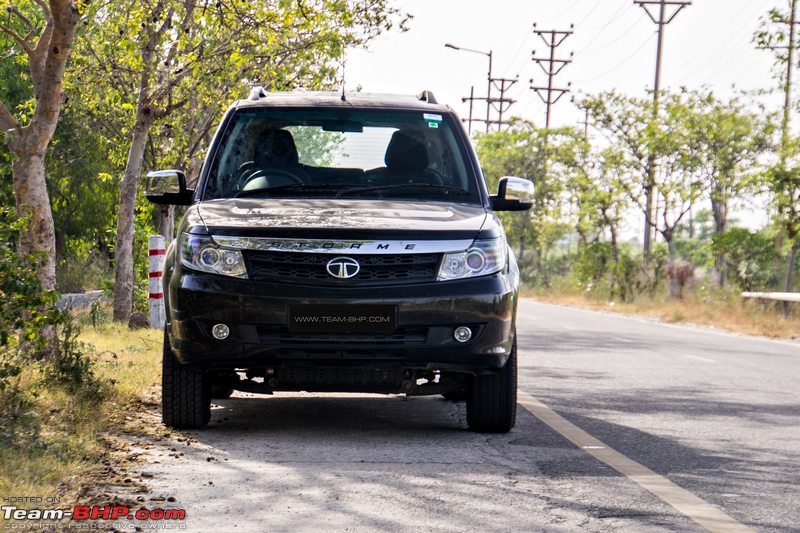 Last edited by GTO : 31st December 2015 at 16:02. Reason: Linking to Varicor 400 review :) |
| |  (47)
Thanks (47)
Thanks
|
| The following 47 BHPians Thank tsk1979 for this useful post: | amit_purohit20, anilntny, AutoIndian, baleno_1.6, bj96, Blue Thunder, Car Stalker, carrazy, darklord, desdemona, fusionbang, ganeshb, Gannu_1, GrammarNazi, GTO, john doe, JoseVijay, Klub Class, mallumowgli, mrbaddy, Nilay, paragsachania, parsh, PGNarain, Ragavsr, RavenAvi, riturajsharma19, rosaf, Rshreyansh, RSR, S2!!!, samabhi, sayakc, scopriobharath, Sheel, SmartCat, sri2012, Storme_on_d_way, swiftnfurious, Technocrat, theexperthand, uday.ere, vb-saan, VeluM, vredesbyrd, xistinchaos, Yeldo |
| |
| | #2 |
| Team-BHP Support  | re: 2015 Tata Safari Storme : Official Review Since the Tata Safari Storme has already been reviewed by Team-BHP, this report will only focus on changes made to the 2015 facelift. For easy reference, here are direct links to the complete Safari Storme road-tests: 4x2 variant: Link 4x4 variant: Link 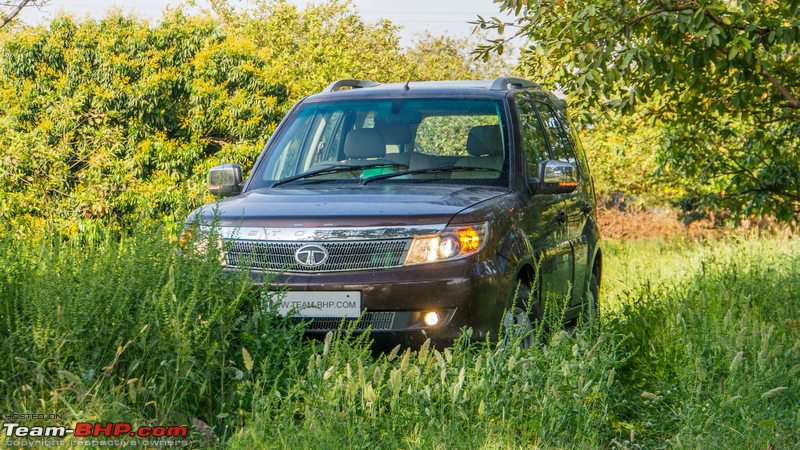 Last edited by GTO : 19th June 2015 at 17:28. |
| |  (25)
Thanks (25)
Thanks
|
| The following 25 BHPians Thank tsk1979 for this useful post: | anilntny, AutoIndian, baleno_1.6, carrazy, fusionbang, Gannu_1, GTO, JoseVijay, Klub Class, mrbaddy, paragsachania, parsh, RavenAvi, riturajsharma19, RSR, S2!!!, sayakc, scopriobharath, Sheel, Storme_on_d_way, swiftnfurious, theexperthand, uday.ere, vb-saan, VeluM |
| | #3 |
| Team-BHP Support  | Available with merely 5 colour options. Two whites, silver, black & urban bronze. Sardinia red dropped: 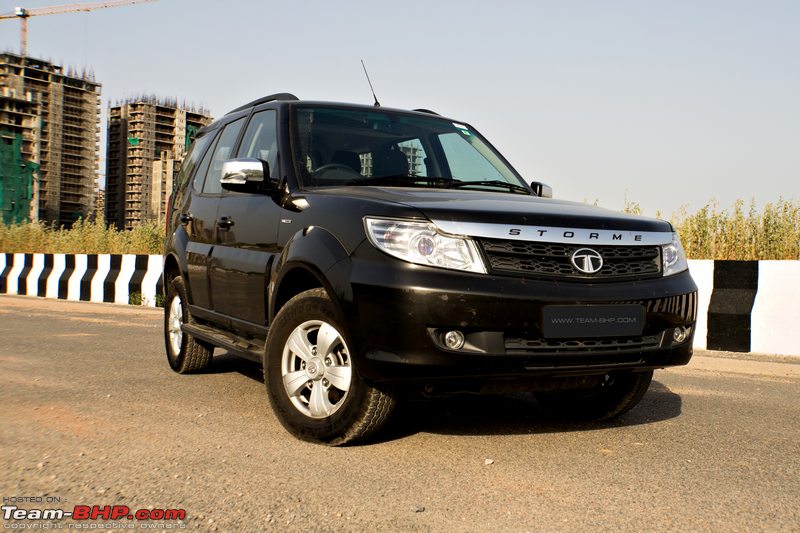 In my 2012 Safari Storme review, I'd commented that it was the best Safari till date. However, despite being a step ahead in every aspect and the superior engineering (compared to the old Safari), the Storme didn't make any impact on the million-rupee SUV segment. The monthly sales average for the Safari + Storme (combined) has been merely 571 units so far in 2015, while the monthly average in 2014 was 797 units. This, at a time when newbies like Renault sell 3,000 units monthly, the indomitable Scorpio does over 4,000 and the XUV500 about 3,000. No doubt, the Safari has quite the fan following and it's gained a cult-like status among some enthusiasts. But there is no hiding the fact that it wears a 20 year old body. Then, Tata's brand is overall suffering in the market. The price & positioning don't help either; the Storme has the cheaper Scorpio facelift to fight on one side, and the very competent XUV500 on the other. It's sandwiched right in between the two popular Mahindras. Competition from car-like monocoque SUVs like the Duster further hit the Safari...the oldest horse from this group. It was in 2014 that camouflaged Safari Storme test mules were first spotted (link to news article). A year later, Tata finally introduces the updated version. The 2015 Storme receives subtle cosmetic changes to the exteriors and interiors, additional equipment, a bump up in power and a couple of mechanical tweaks. 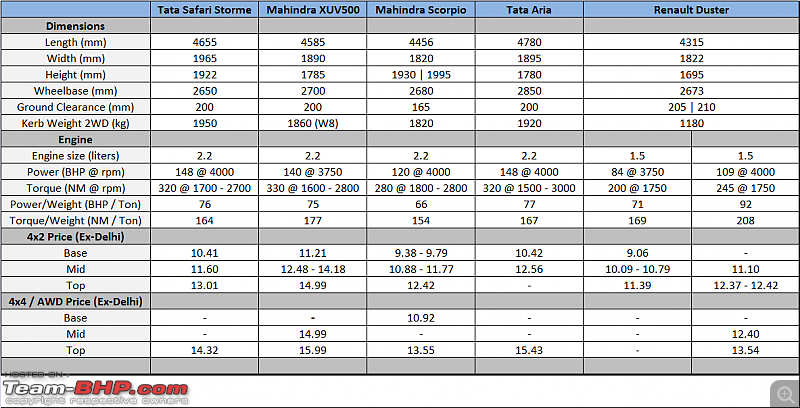 Here are the before & after prices (thanks to BHPian M35): 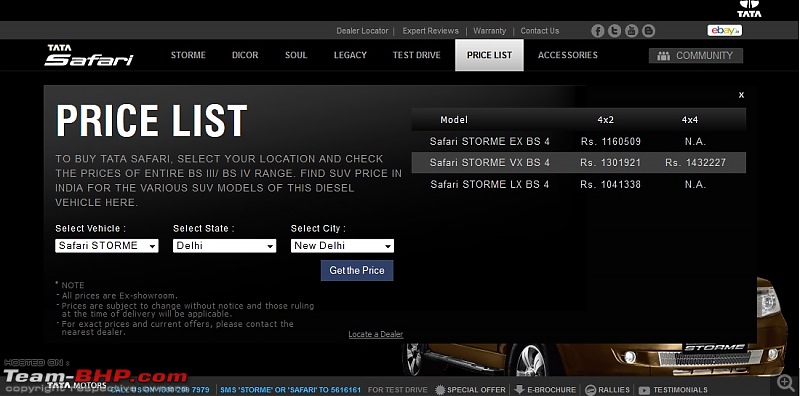 The only noticeable change is that the LX has gotten cheaper by 42k. With the price falling below 10 lakhs, there will be substantial road tax savings in some states (thanks to the silly system of non-incremental, but absolute tax brackets): 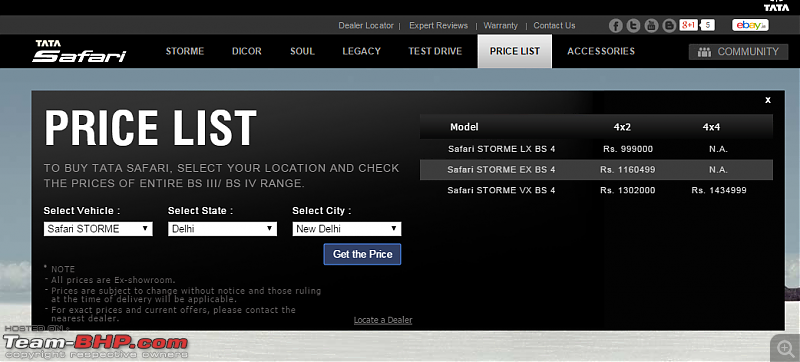 Equipment spread across variants: 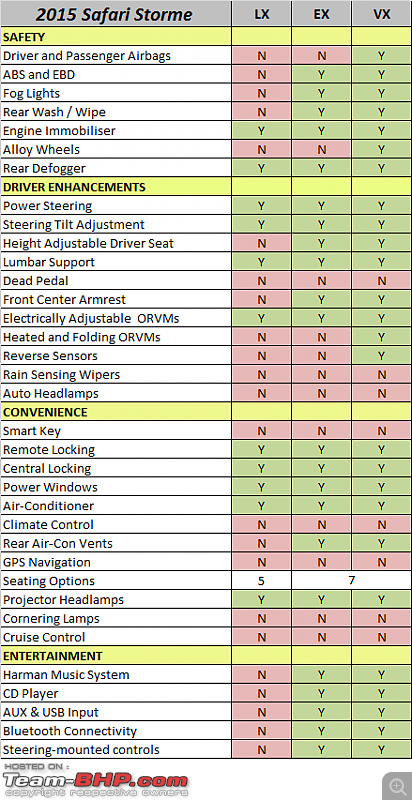 So, what's new on the outside? Changes on the outside are negligible. Spot the differences (hint = exactly 2 changes): 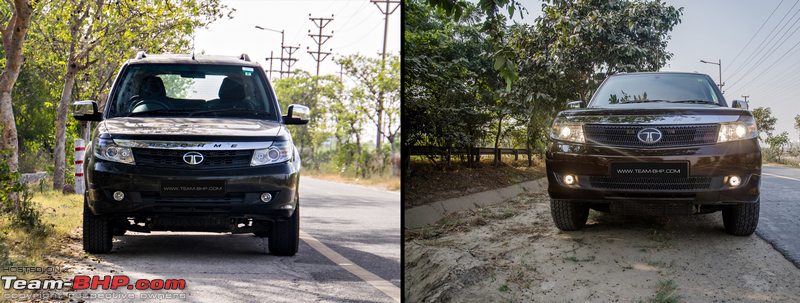 The new Land Rover-inspired grill pattern is the most prominent difference:  Chunky chrome unibrow now has the 'STORME' engraved in black: 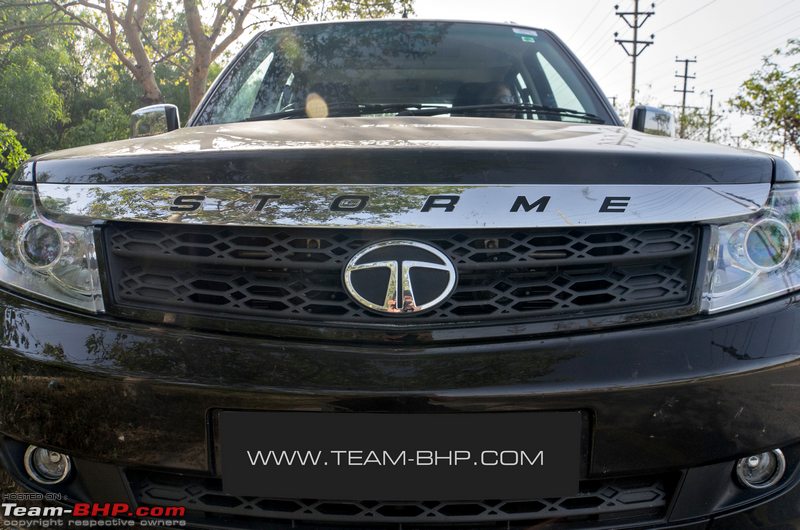 Projector headlamps are standard across all variants: 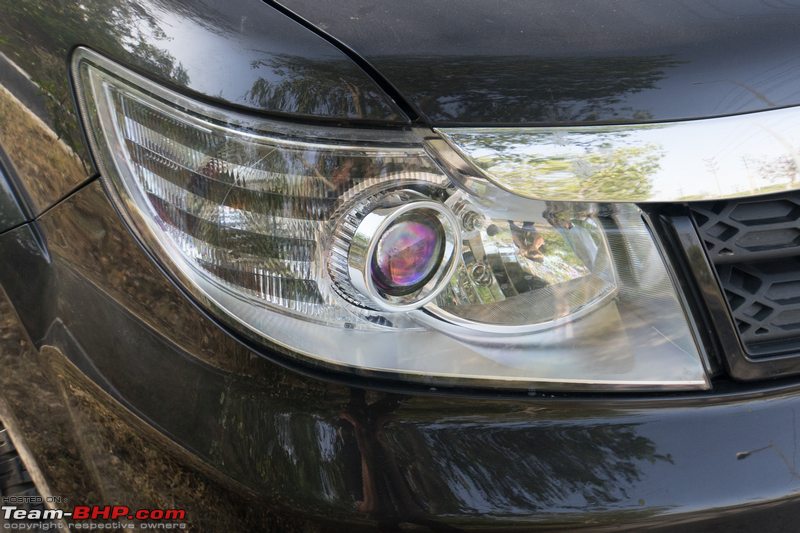 Side profile remains unchanged, except for darker roof rails and the strip above the 3rd-row glass: 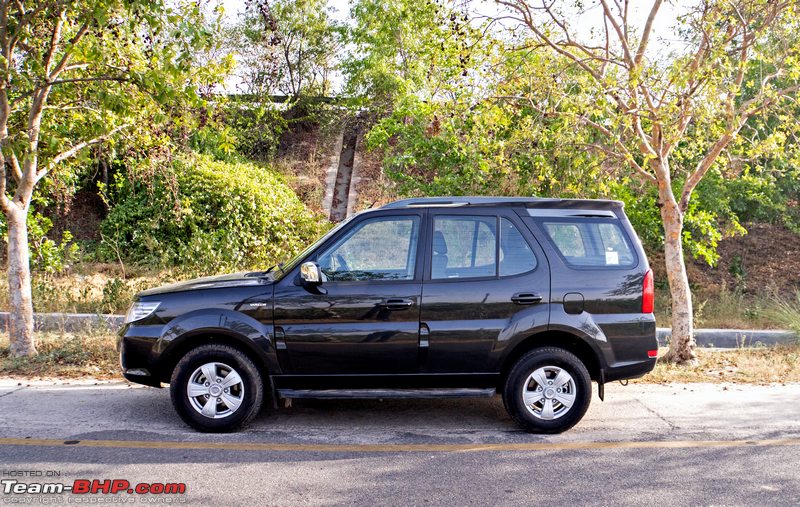 New 'VARICOR' badges on both front fenders: 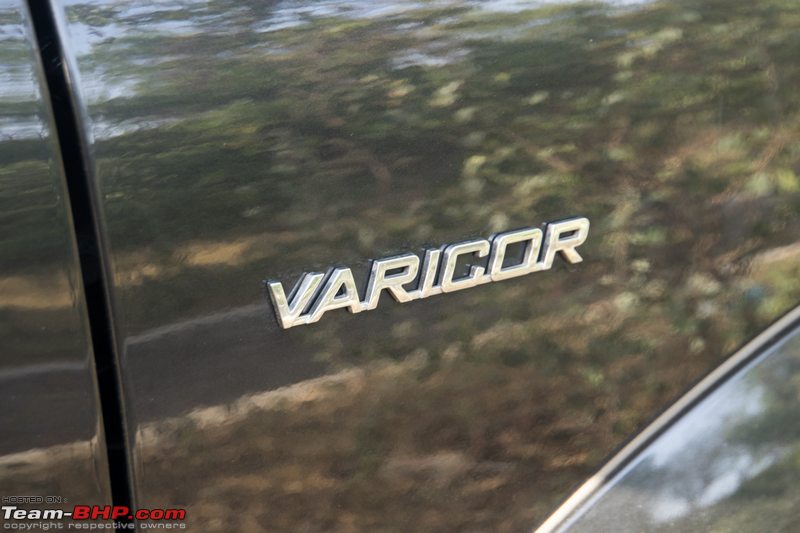 The same smart rear. The Safari has built an enviable, macho image. It's more of a halo product for Tata than the expensive Aria: 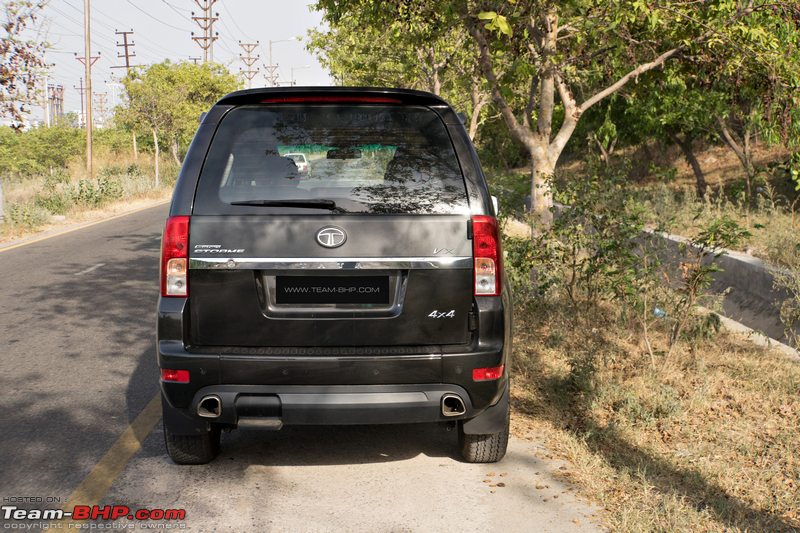 Tata should have at least offered a fresh rim design to bring some novelty to the 2015 version:  Two night shots: 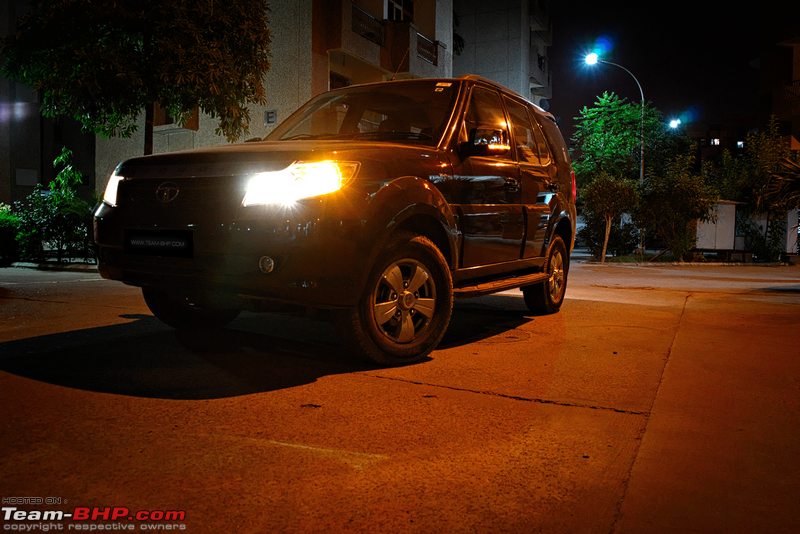 Excellent puddle lamps light up the ground: 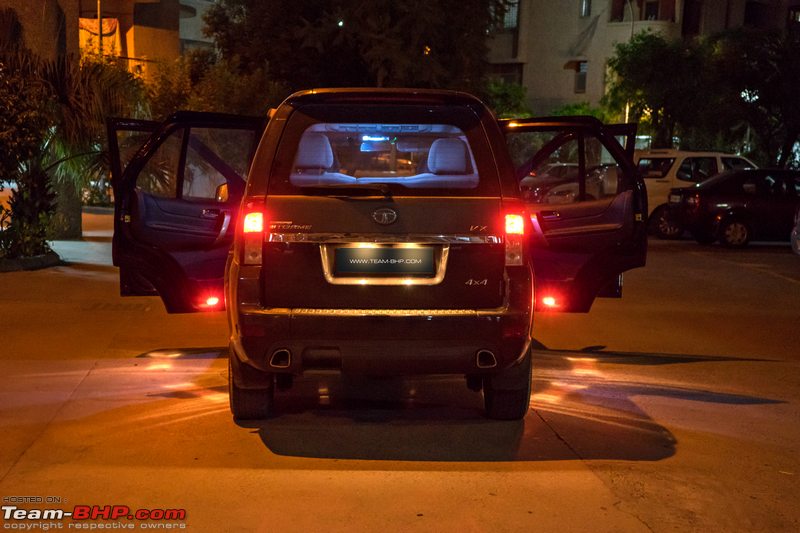 Last edited by GTO : 19th June 2015 at 17:29. |
| |  (34)
Thanks (34)
Thanks
|
| The following 34 BHPians Thank tsk1979 for this useful post: | AutoIndian, AVR, baleno_1.6, benbsb29, carrazy, Crazy_cars_guy, darklord, dreamliner17, fusionbang, GTO, JoseVijay, Klub Class, manson, mrbaddy, parsh, RavenAvi, Rock 'n' rollz, rosaf, Rshreyansh, RSR, S2!!!, samabhi, sayakc, scopriobharath, Sheel, Simhi, SmartCat, swiftnfurious, Technocrat, theexperthand, uday.ere, vb-saan, VeluM, vredesbyrd |
| | #4 |
| Team-BHP Support  | re: 2015 Tata Safari Storme : Official Review So, what's new on the inside? The biggest updates have been given to the interiors. We saw Hyundai going the black way with the 2015 Elantra and now, Tata swims against the tide, opting for a black + dark brown + grey interior theme. This, with the improved quality, makes the cabin feel more upmarket:  New vs old comparison. See how classy silver has replaced the faux wood inserts:  The new steering wheel is nice & chunky (it's not the same as the Zest's):  Steering finally gets audio & phone controls (earlier audio controls were located on the indicator stalk): 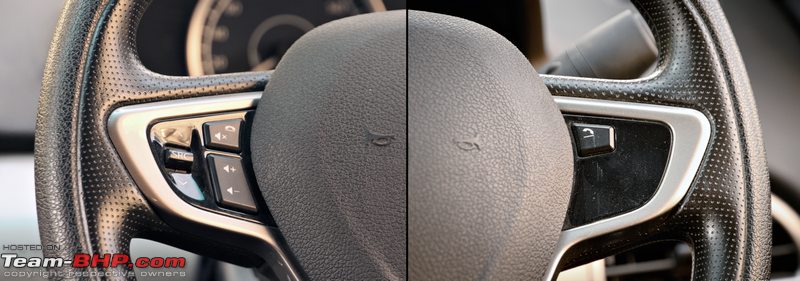 New vs old. 2015 steering looks more contemporary: 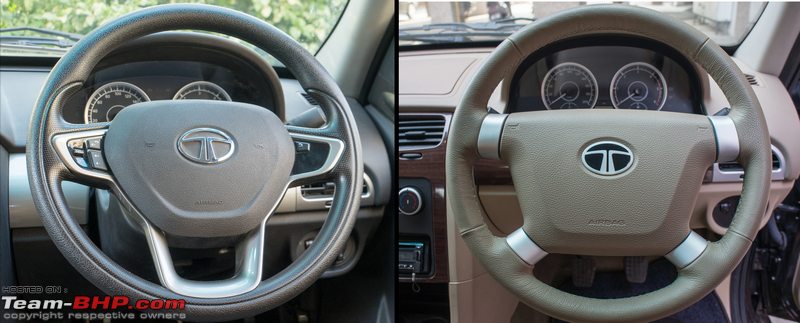 Taller drivers like me will no longer rub their thighs against the steering. Can't put a finger on it, but it's either the steering or the seating position. In this picture, also notice the black carpeting which is preferred over beige for Indian conditions:  Simple, functional meters. MID still not offered  . Come on Tata, even the Nano has one!! The outside temperature display is gone; all you get are two trip meters & an odometer: . Come on Tata, even the Nano has one!! The outside temperature display is gone; all you get are two trip meters & an odometer: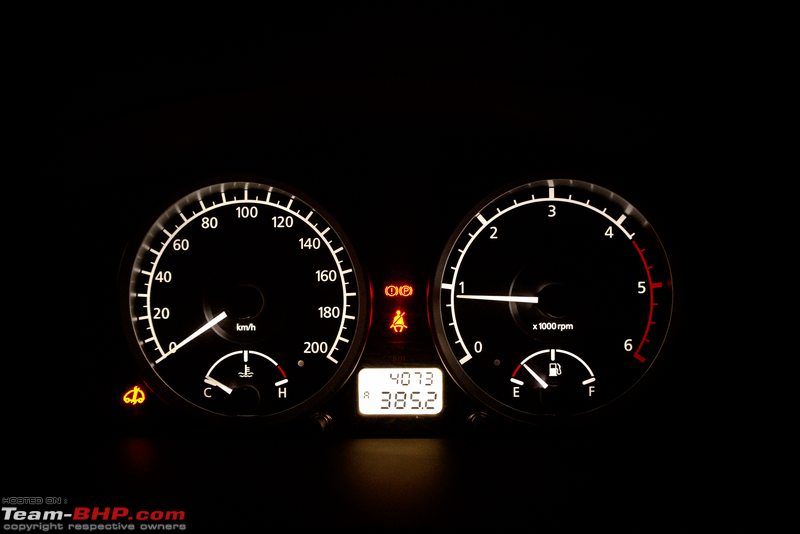 New vs old doorpads. Darker ones will be relatively easier to maintain: 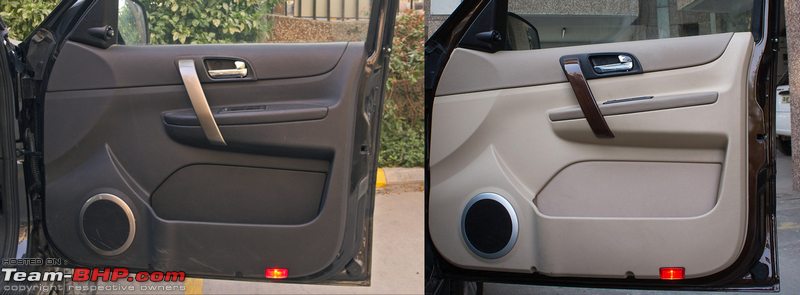 The traditional Safari strengths are carried forward. Just like before, you walk in and sit down. As far as the driver's seating position is concerned, the 2012 Storme felt like a downgrade from the DiCOR, but Tata has rectified this in the 2015 Storme. Seat quality is top-notch. Fabric seats, instead of the leather I'd seen in my 2012 test car: 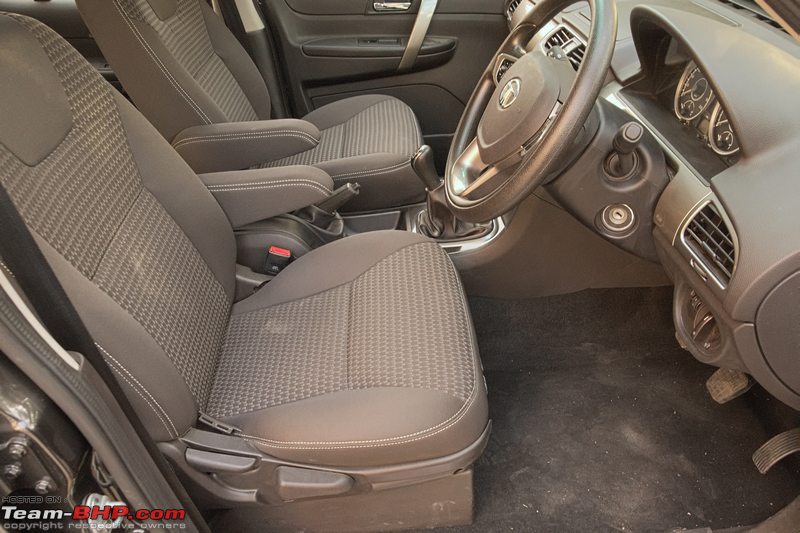 Although cabin quality has improved, inconsistencies aren't hard to find: 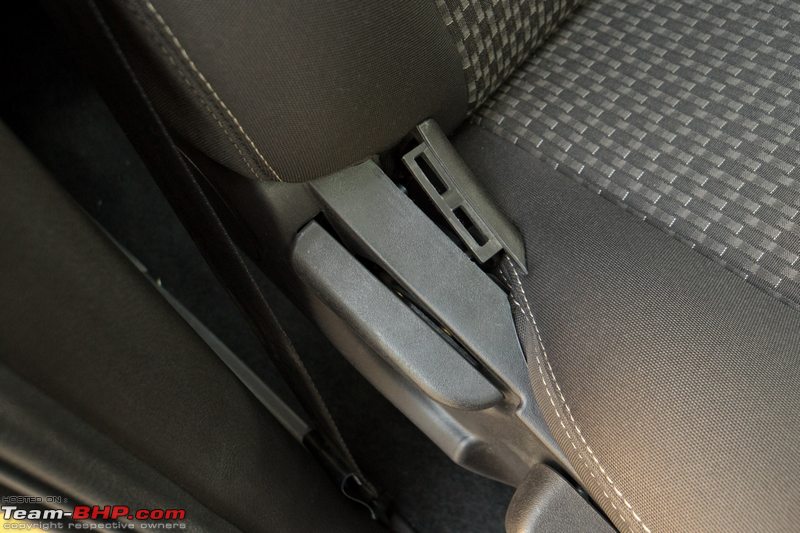 Black Safari-badged cover replaces the analog clock (purists will miss it). That said, the new head-unit always tells the time (even when it's off). No climate control in an SUV that costs well over 15 lakhs on the road! 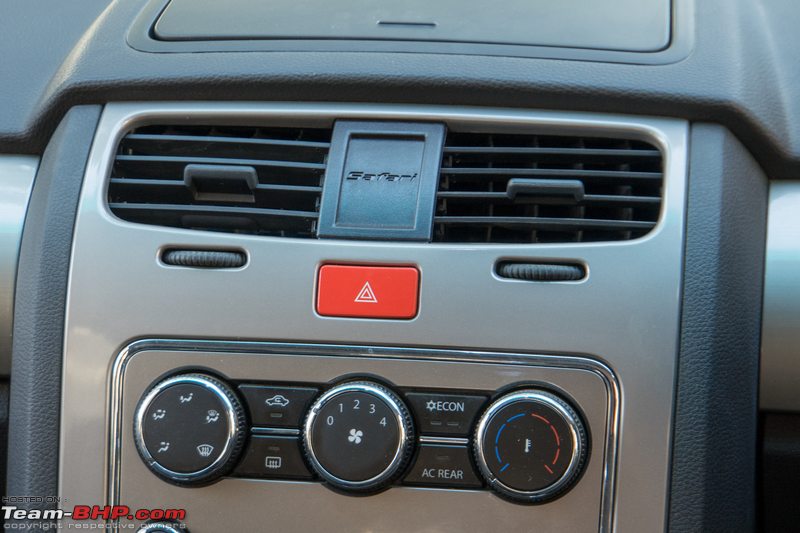 Tata has given in to a decade-long demand from owners, with the Storme getting a Harman-developed double din head-unit. This 6-speaker system sounds good and has all the modern connectivity options (including Bluetooth). Too little too late? Competition has moved on to entertainment systems with a touchscreen & navigation (even the humble Zest has one): 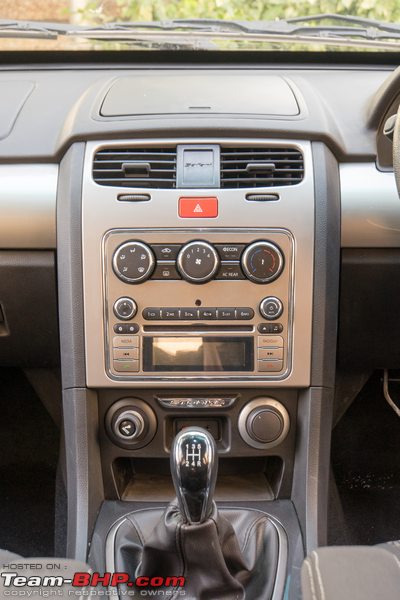 Parking sensor display is now on the head-unit (as opposed to the IRVM). While reversing, you can't rely only on the parking sensors, due to their limited coverage of the corners of this mammoth SUV. A reversing camera is sorely missed: 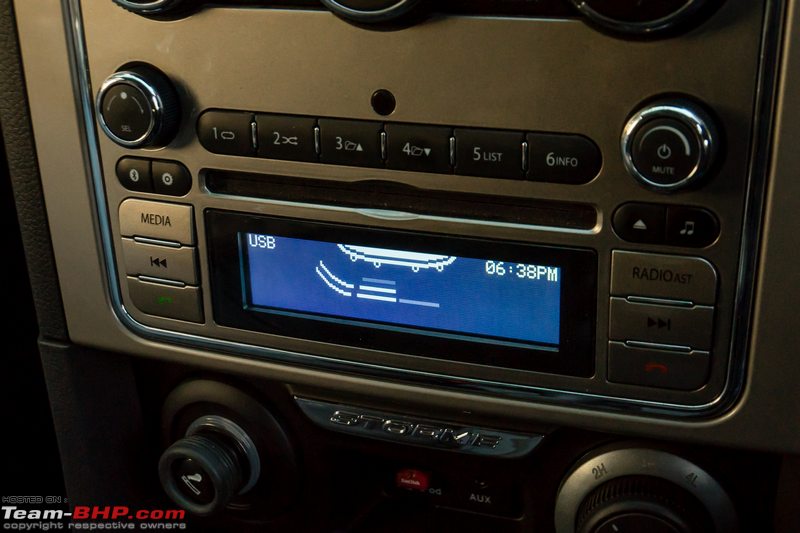 New vs old. The shift-on-the-fly 4WD knob & cigarette lighter move up to the center console (they were earlier placed between the gear lever & handbrake): 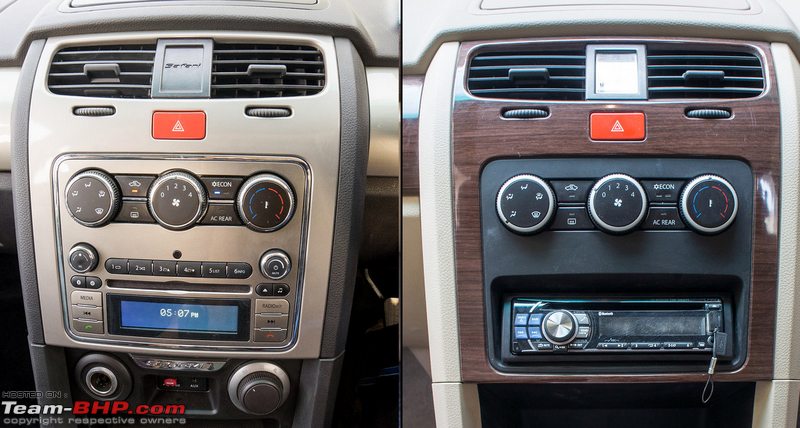 At the base is a storage area to park your smartphone. To accommodate the 4WD control's new position, the front cup-holders (originally placed here) have been removed: 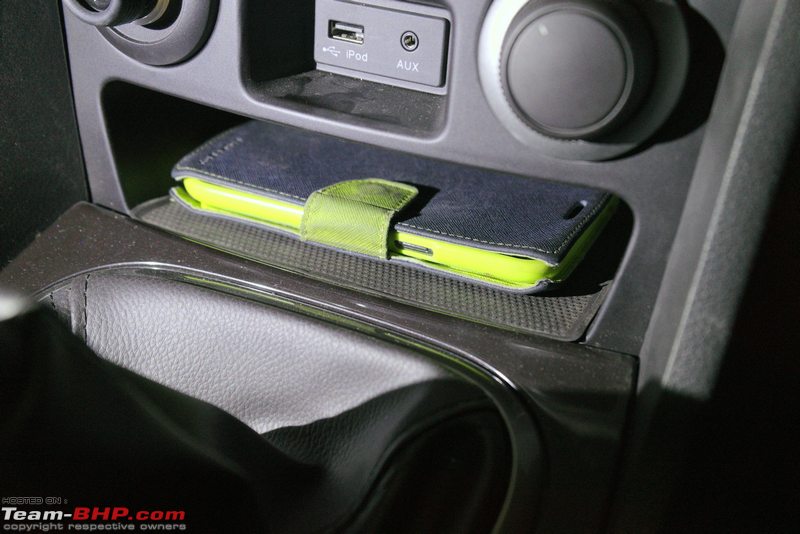 The Storme sports a short gearshift, which can make shifting into 5th a tad inconvenient. With the armrest down, shorter drivers might find it difficult to change gears. I didn't like the hard material...it can also get uncomfortably hot when parked under the sun. Having said that, the quality of the faux leather base is much better than before. At idle, the gearshift doesn't dance much (it does at shut down though): 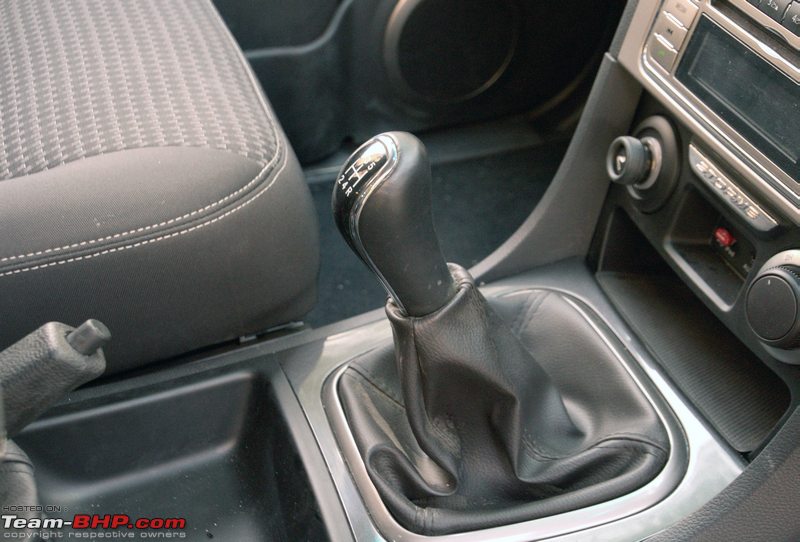 A large circular storage area (behind the handbrake) in place of the rectangular cubicle (link to image): 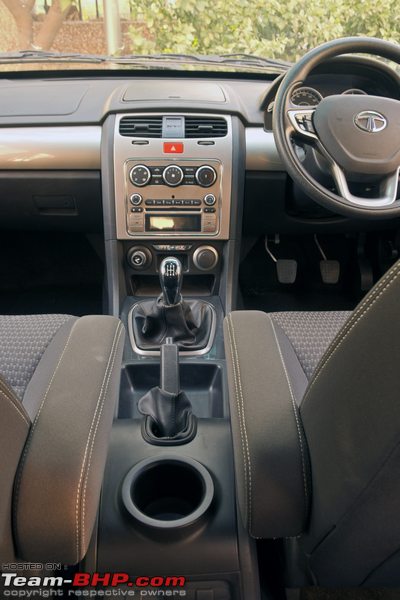 You get a flippy key, but only one (not for the spare). Flippy key is built tough. Thoughtful touch = If you press the unlock button once, only the driver's door will unlock; a second press will unlock all doors:  The IRVM is a manual prismatic unit, instead of the auto-dimming type. The older IRVM was a notch above in terms of quality and looked classier, but it lacked the useful dimming function: 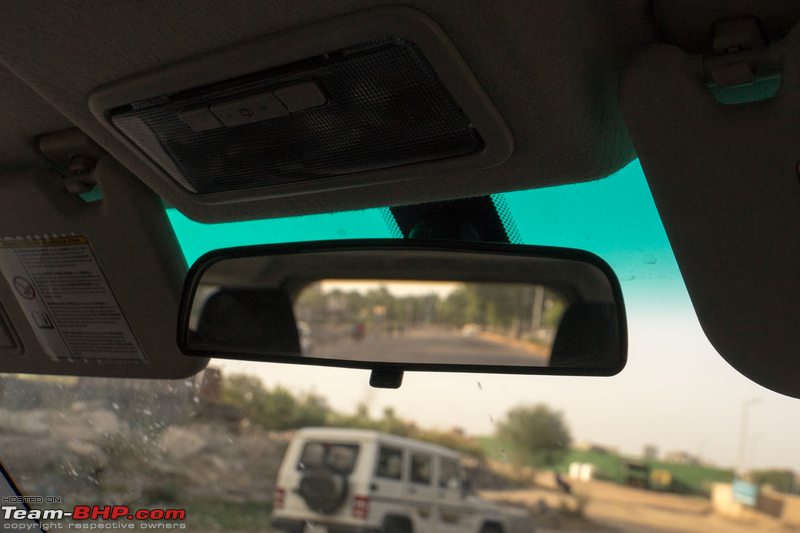 The ORVMs & IRVM together provide good visibility: 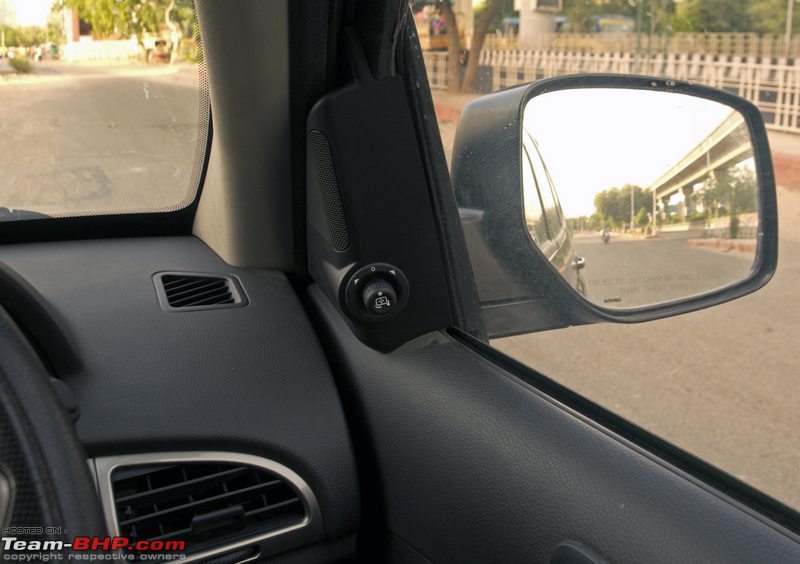 Cost cutting! Glovebox's felt-lining is gone: 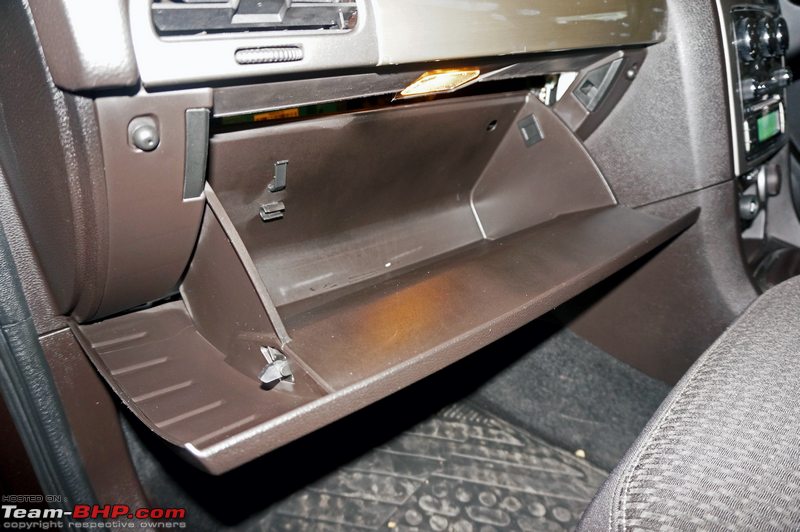 Other changes include LED cabin lamps... 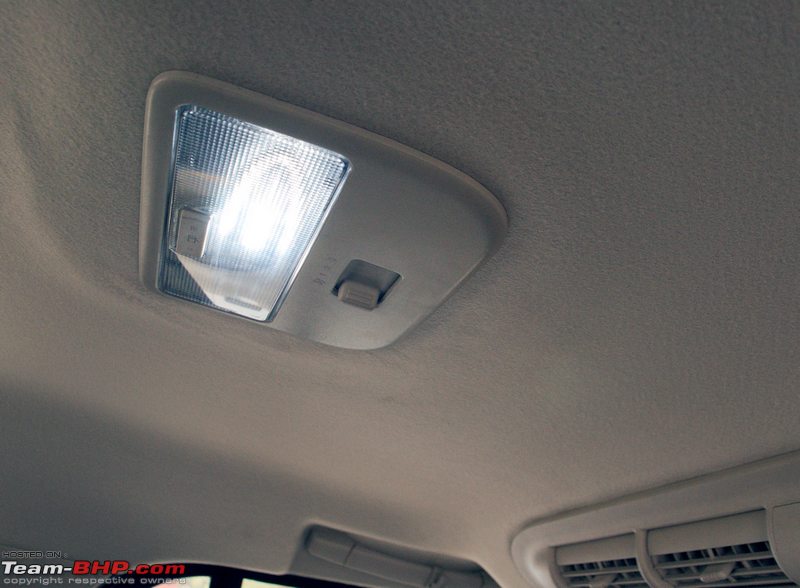 ...which bathe the interiors in cool white light: 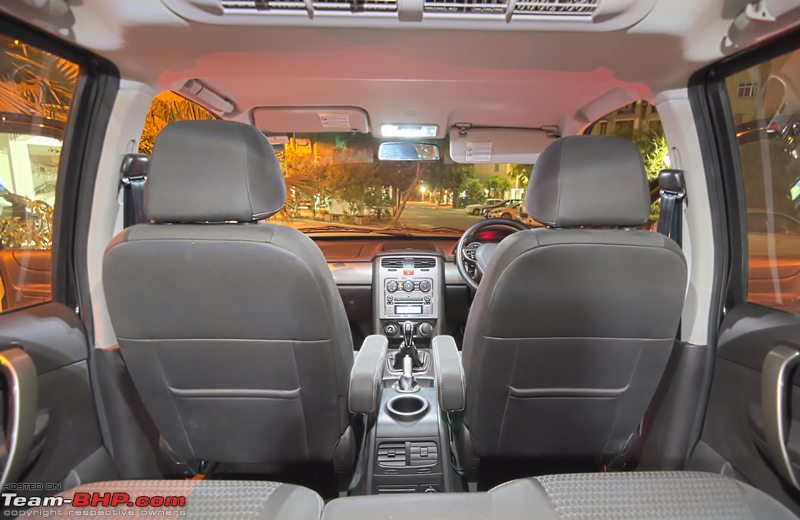 Why fix something that isn't broken? A look at the comfortable middle row: 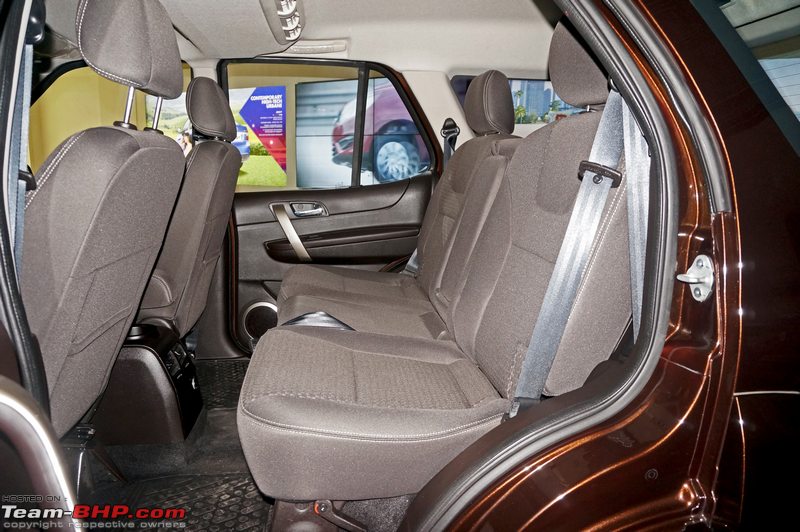 3rd row jump seats are uncomfortable to get onto...and uncomfortable to sit. Best left to kids (This is how it looked the last time I was here): 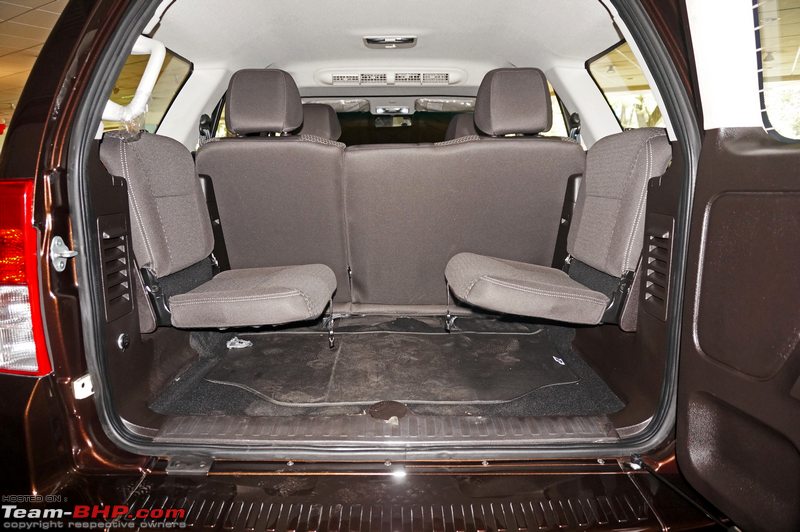 Last edited by GTO : 28th June 2015 at 19:34. |
| |  (35)
Thanks (35)
Thanks
|
| The following 35 BHPians Thank tsk1979 for this useful post: | anilntny, AutoIndian, baleno_1.6, Car Stalker, carrazy, dreamliner17, fusionbang, Gannu_1, GrammarNazi, GTO, JoseVijay, Klub Class, manson, mrbaddy, parsh, RavenAvi, rosaf, Rshreyansh, RSR, S2!!!, samabhi, sayakc, scopriobharath, Sheel, Simhi, SmartCat, swiftnfurious, Technocrat, The Rationalist, theexperthand, uday.ere, vanatlarj, vb-saan, VeluM, vredesbyrd |
| | #5 |
| Team-BHP Support  | re: 2015 Tata Safari Storme : Official Review Same 2.2L diesel, with 10 more horses:  The Storme is powered by the same 2.2 liter diesel motor with boost coming from a variable geometry turbocharger. Running the Aria's state of tune, it churns out 10 horses more...that's 148 BHP (@ 4,000 rpm)! The torque rating remains the same @ 320 Nm (1,700 - 2,700 rpm). Fire up the engine, and the first thing you notice is how quiet the new Storme is. The 2012 Storme impressed me with its sound deadening, yet this one is a new wonder altogether! Once the engine has warmed up, it is impressively refined. Slot the Storme into 1st gear and you'll immediately appreciate the minimal turbo-lag. Power delivery is fairly linear in nature, with the motor delivering excellent driveability for city runs (as big diesels usually do). This linear power map is very practical. You can make the Storme putter around all day long at rpms as low as 1,200, without any kind of vibrations or shuddering. This has been accomplished by using a Torsional Vibration Damper that keeps the shakes and shivers to a minimum. Tata's 2.2L diesel is a tractable engine in all kinds of traffic & terrain scenarios. This SUV has always been an able highway machine and the 10 additional horses make the Storme feel slightly peppier than before. Overtaking is quick & easy (further helped by the excellent driver visibility). As was the case earlier, the tall 5th gear brings relaxed cruising ability and the Storme can happily munch kms at three digit speeds all day long. There is an ample amount of torque available at 1,500 rpm and beyond, thus you don't need to downshift too often on the highway. On a related note, I might add that wind noise is well controlled at speed (in contrast to the hurricane effect of the old Safari). In terms of fuel economy, Safaris usually deliver about 10.5 - 11 kpl in the city and 13 - 14 kpl on the highway. The light clutch pedal is a pleasant surprise. As you stomp on the clutch, conditioned by years of heavy SUV pedals, you'll realize that the Safari's new clutch can even put some petrol cars to shame. Tata has really worked some kind of magic here. The pedal is effortless to use! Additionally, this new clutch is the 'self-adjusting' type. There's still no dead pedal though; I wonder just how much they save by skimping on this useful accessory. That said, due to the high seating position, you aren't as uncomfortable as in sedans without a dead pedal. Insulation levels have noticeably improved on the 2015 model. The earlier Storme was fairly silent, this one takes it to the next level. It's ridiculously easy to hold a conversation inside the car when pushing north of a hundred. Even tyre noise is limited, no doubt helped by the wheel well insulation. As BHPians will know, the Safari Storme deploys the modern X2 chassis (first seen on the Aria). Tata appears to have firmed up the suspension a little bit. Comfort levels are still an advantage of the Storme, and it rides nice & flat. But the 2015 Storme can't take sharp bumps or lateral undulations as well as the 2012 Storme. On broken roads, you can feel the ride being firmer. To put things in perspective, I'd give the earlier Storme's ride quality a 9 / 10 rating. The 2015 car? An 8 / 10. Still a lot better than the likes of the bumpy Scorpio, yet not absolutely plush as the softer suspension of the original Storme. What you won't like is how bad roads are directly felt on the steering. The slight firming up has improved the Storme's handling & road behaviour. While roll is present, it's not excessively scary. You can change lanes on the expressway without upsetting her composure. Neither driver nor car feels nervous at 120 kph on the highway. No, it's no corner carver and you should definitely maintain a conservative driving style. As long as you remain mindful of the fact that the Storme is a tall 2 tonne SUV, you won't be disappointed. Of course, monocoque SUVs like the Duster & XUV500 will run rings around it. Equally, I might add that the on-road behaviour is far superior to the likes of the Mahindra Scorpio. The hydraulic power steering adequately weighs up at speed. Conversely, it's not as light as the Scorpio's steering at parking speeds or within the city. The relatively small turning radius of 5.4 meters makes things easier in urban confines. It's actually comparable to midsize sedans (e.g. Toyota Altis = 5.3 meters). On the braking front, I'm disappointed that the base LX variant no longer gets ABS or rear disc brakes. I drove the higher variant with ABS, EBD & discs on all 4 wheels. The overall braking is safe & predictable. Thanks to the firmer suspension, brake dive has reduced compared to the earlier version. There is no change to the 4x4 drivetrain. You get a low range 4x4 transfer case, limited slip differential, 200 mm of ground clearance and sufficient rear wheel articulation. Unfortunately, the transfer case is still exposed, and water splashes could make your 4x4 malfunction. Interestingly, the engine can now run 20,000 kms between oil changes! As opposed to API CH-4, the 2015 Storme uses API CI-4 engine oil. The long change interval is welcome, but I have my doubts on the availability of this oil in smaller towns. On the flip side, the service interval has come down from 15,000 to 10,000 kms. That means more frequent dealer visits for those with high running. Another notable difference is the 20,000 km change advisory for the "element cartridge" inside the pre-filter / sedimenter (water separator). Earlier, this expensive unit had to be entirely replaced every 100,000 kms, and there was no concept of cleaning or part replacement (apart from water drainage). Replacing only the element cartridge is a welcome move, considering our terrible fuel quality & the fact that the part should cost merely a couple of hundred rupees. Finally, Tata has listened to owners and upped the fuel tank capacity from 55 to 63 liters (just 2L lesser than the old Dicor). I'm worried about the fuel tank's placement though. It seems to be susceptible to hits. Even the sedimenter (water separator) is prone to underbody impact. If you are going to frequently cross rocky terrain, install a fuel tank guard. So overall, what has Tata created here? Well, it's a minor facelift, with some minor changes under the hood. There is one thing which Tata didn't upgrade = the elephant in the room called "Component Quality". Our test Storme with 4,000 kms on the odo didn't have a working 4x4 low box. Probably a faulty clutch sensor? Barely 100 kms into the test, the service light came on. 50 kms later, the SUV refused to start. Somehow, I could make her start by holding the key in crank position, shifting to first and then back to neutral (only a Safari owner would attempt these tricks). It's things like these which scare away countless buyers. Tata needs to get its act together in terms of product quality & reliability. The standard warranty is for 3 years / 100,000 kms. We highly recommend the extended warranty pack that adds another year & 50,000 kms of coverage. New vs old. Finally, a properly bolted engine cover! Sound deadening seems to have been beefed up:  Wheel well insulation significantly reduces tyre noise inside the cabin:  Suspension appears to be running a slightly firmer tune:  Bigger 63 liter fuel tank = longer range. If you're going to frequently cross rocky terrain, I'd strongly recommend a fuel tank guard:  The 2015 Storme has 10,000 km service intervals and interestingly, 20,000 kms between oil changes! 20,000 km change advisory for the "element cartridge" inside the sedimenter (water separator) too. Timing belt life has increased to 150,000 kms: 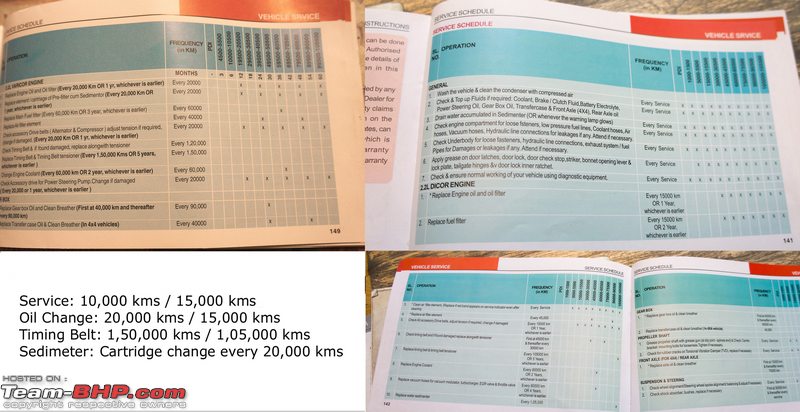 As opposed to API CH-4, it now uses API CI-4 engine oil. The long change interval is welcome, but I have my doubts on the availability of this oil in smaller towns: 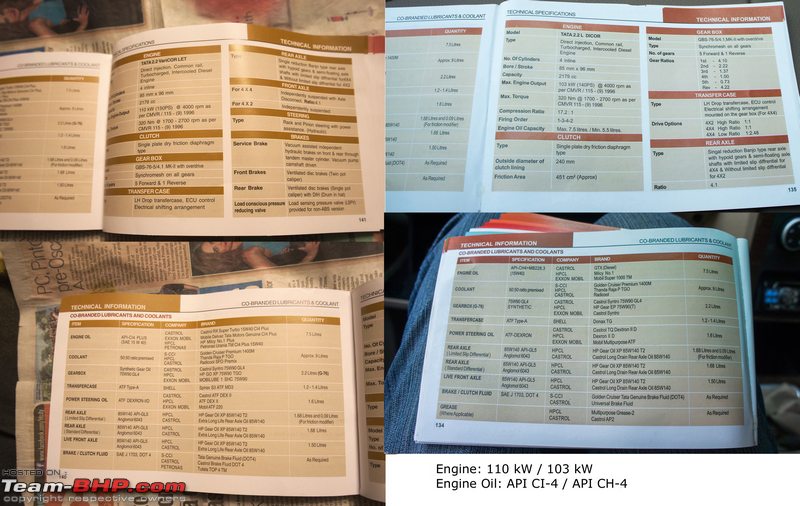 Seen this ad from Indonesia?  Last edited by GTO : 28th June 2015 at 19:34. |
| |  (60)
Thanks (60)
Thanks
|
| The following 60 BHPians Thank tsk1979 for this useful post: | aalokg, Abhi99, ACFT, ACM, Aficionados, aniketi, anilntny, aviddenis, AviG, baleno_1.6, benbsb29, Car Stalker, carrazy, darklord, deepaktpatil, dreamliner17, fusionbang, ganeshb, Gannu_1, gopa99, GrammarNazi, GTO, InControl, JoseVijay, Klub Class, lamborghini, Latheesh, mallumowgli, manson, mrbaddy, NirmalK, param22k, parsh, PGNarain, Prowler, RavenAvi, rrsteer, RSR, S2!!!, safari_lover, samabhi, sbalagru6, scopriobharath, sdp1975, Sheel, SmartCat, sourabhzen, sri2012, Storme_on_d_way, sujithpnair, Swapnil4585, swiftnfurious, Technocrat, The Rationalist, theexperthand, uday.ere, vb-saan, VeluM, vredesbyrd, Zahoor23 |
| | #6 |
| BHPian Join Date: Nov 2014 Location: Pune
Posts: 26
Thanked: 70 Times
| Re: Scoop: Updated Tata Safari Storme in the offing? EDIT: Now launched Finally got my hands on the real thing at Pandit Auto, Pune yesterday. The ODO read 58 km.. looks like not too many TDs have happened. What I liked based on the fact that this is just my 2nd time with the beast or any big SUV for that matter: - The seating position is comfortable and I like the steering's angle to the seat. - Steering is light - Gear throw though long is effortless - The clutch is light I suppose, since I am not sure what it was before this. - Car handling is great. - The car jumps when you press the accelerator upon changing gear... to me a sign of a responsive engine, not sluggish. To me. - No substatial body roll, but then I drove in traffic so no chance to speed or swerve. - The interiors finish is great. - Storage is within reach and ample. - I like it that I can see the entire hood end to end!  - Ample space in general for all passengers, except the last 2 seat, but I forsee using it only for my bicycle or luggage. - Delivery time is 2 weeks. What I did not: - The seat seems to finish abruptly..not much thigh support. I could live with it, but any scope for getting better seats installed? - The fact that I have to look at the LCD display, i.e. downwards to see what the sensor indications are while reversing, when my eyes should be on the RVMs and backwards. Maybe a reverse camera will solve that problem. - Tata dealers are doing much disservice to a great vehicle by not being enthusiatic about its sale. - The mid variant has no airbags. I have attached the rates for the new Storme as quoted by Pandit Auto. Big difference between these and the ones quoted by Concorde, Pune. See past post here. Handling charges Rs 1000 difference as is in the extended warranty. Are these at the dealer's discretion, esp. the warranty? Overall Pandit is quoting much less for PCMC while they are higher than Concorde for PMC for the VX 4x2. Surprisingly PCMC price is high in Concorde quote.  . I am planning to check with National, the only other dealer left to be covered in Pune, about their prices. . I am planning to check with National, the only other dealer left to be covered in Pune, about their prices. |
| |  (23)
Thanks (23)
Thanks
|
| The following 23 BHPians Thank xistinchaos for this useful post: | Aficionados, amit_purohit20, AutoIndian, baleno_1.6, Contrapunto, fusionbang, GTO, JoseVijay, mallumowgli, mrbaddy, Nilay, nordmariner, PGNarain, RavenAvi, rkbharat, RSR, S2!!!, scopriobharath, sdp1975, Storme_on_d_way, theexperthand, uday.ere, vb-saan |
| | #7 |
| Team-BHP Support  | Re: 2015 Tata Safari Storme : Official Review Thread moved from the Assembly Line to Official Reviews. Thanks for sharing. No one knows & understands a car better than its owner. You just proved it, Tanveer - rating your review 5 stars   ! ! |
| |  (3)
Thanks (3)
Thanks
|
| The following 3 BHPians Thank GTO for this useful post: | baleno_1.6, Swapnil4585, uday.ere |
| | #8 |
| Distinguished - BHPian  | Re: 2015 Tata Safari Storme : Official Review Tsk - how is its low-end driveability? I remember the previous version was more of a highway champion. Also, will Tata continue to sell this avatar alongwith previous avatars like before? |
| |  ()
Thanks ()
Thanks
|
| | #9 |
| Senior - BHPian | Re: 2015 Tata Safari Storme : Official Review Thanks Tanveer for such detailed and helpful review. I took a test drive of new Storme last week and found operating the gear lever a bit uncomfortable due to arm rest as compared to my swift (with after market arm rest). The steering wheel, though looked nice, was hard plastic and felt cheap. Last edited by GTO : 20th June 2015 at 14:28. Reason: Typo |
| |  ()
Thanks ()
Thanks
|
| | #10 |
| BHPian Join Date: Sep 2012 Location: Mahe
Posts: 101
Thanked: 197 Times
| Dears, just took delivery of my Ex. Was wondering if the music system comes with a remote control or not. Couldn't find one, even the showroom guy seemed clue less! Can some one help me confirm if this new harmon kardon unit comes with remote control or not? |
| |  ()
Thanks ()
Thanks
|
| | #11 |
| BHPian Join Date: Dec 2010 Location: YVR/CHD
Posts: 756
Thanked: 896 Times
| Re: 2015 Tata Safari Storme : Official Review Excellent review Tanveer, great follow up to your truly awesome review of the newly launched Storme few years back. As for the looks being unchanged, I would be interested to know if someone has a genuine issue with that. And considering what Mahindra did with the Scorpio, even more so  A lot of people facing the Safari/Scorpio dilemma might tilt towards the Storme for the looks alone. A lot of people facing the Safari/Scorpio dilemma might tilt towards the Storme for the looks alone. Glad to know that the clutch is now super light, it's been a major grouse while driving in the city. I've also come to realize that the visibility offered by the high seating is a major stress relief in City traffic compared to sedans, and should be a significant enough factor while deciding what to buy. A little  Must say that the present gen Safari is quite under rated considering the product strengths. It's nowhere as bad as the resale value would make one believe. In fact any post 2012 unit is a steal for the amount its selling nowadays. |
| |  (1)
Thanks (1)
Thanks
|
| The following BHPian Thanks avisidhu for this useful post: | desdemona |
| |
| | #12 |
| BHPian Join Date: Aug 2006 Location: London
Posts: 74
Thanked: 84 Times
| Re: 2015 Tata Safari Storme : Official Review Great Detailed Review! This car has been a love for many since ages and I personally loved the DiCor. Tata has not done justice to this beast, This could have been easily one of the top selling hi end SUVs in the Indian market, Once it became politicians delight and I guess it still is as they do not have to maintain it from their own pockets. Maintenance becomes a real challenge once you get this beast home and which is where others like Scorpio make way and became so popular. Next is price, if one has to spend 15L on an SUV, he gets XUV500 which is much more loaded and smart than the sluggish Tata + better after sales of Mahindra. I really wish TATA works upon this old giant and revives it. Last edited by GTO : 20th June 2015 at 14:31. Reason: Language |
| |  ()
Thanks ()
Thanks
 |
| | #14 |
| BANNED Join Date: Jun 2015 Location: Amritsar
Posts: 17
Thanked: 2 Times
| Re: 2015 Tata Safari Storme : Official Review I am sure- many of us grew up dreaming the beast in their courtyard, the 2.2 Dicor still sells in good numbers compared to storme. Wish tata to do justice with the safari. I am sure if they reintroduce the old safari with modern engine, decent interiors and no nonsense electronics retaining the old shape. It will surely top the charts ( at least for TATA).  Tata are you listening  |
| |  ()
Thanks ()
Thanks
|
| | #15 |
| BHPian Join Date: Dec 2012 Location: Chennai
Posts: 261
Thanked: 423 Times
| Re: 2015 Tata Safari Storme : Official Review Dear Tanveer, Thank you for the review. The storme has been made more desirable with good music system, clutch, and other improvements which we may not be able to see . But I lost my favorite colors , Cycus Grey from the older Safari, Sardinia Red, and the half white color from the 1st iteration of the Storme (Don't recollect the name) I test drove the storme and loved it despite the TD vehicle being in bad shape at VST Poonamallee in 2014. I rode the Fortuner and had a back ache. Though I am not going to buy one in the next 5 years, who knows if Storme would still be around till then, I feel sad that this SUV still does not get upgraded to what we expect to see. The Indica, Manza and Zest were the ones who brought in many segment first features like unparalleled Space(Indica), Bluetooth compatibility, steering wheel operated controls, ABS to all versions, Good quality music system etc. Why not with the Safari Storme? Cruise Control/backup camera would be greatly appreciated, forget the 3rd row seats, sunroof,lane departure gadgetry, TPMS etc. My family has always been TATA fans with Indicas(2), Indigos(2) and Manzas(2) so there is an emotional bonding to the Company and its products. |
| |  (5)
Thanks (5)
Thanks
|
| The following 5 BHPians Thank TorqMaster for this useful post: | amitwlele, Dr.Suraj, GTO, madhu33, Reinhard |
 |

